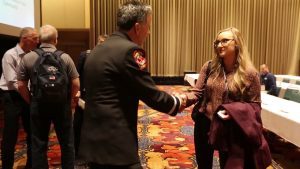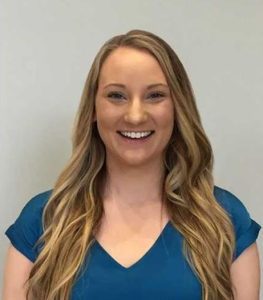Human Factors Expert Partners With First Responders To Improve Technology

Emerging technology like augmented and virtual reality holds huge potential to increase safety for first responders, but it can do more harm than good if not tailored to their specific needs.
That’s where human factors experts like Kate Kapalo, ’20, Ph.D., step in.
Today Kapalo brings UCF psychology degrees and years of experience working closely with the military and public safety to her research and teaching position at the University of Nebraska at Omaha. Her resume includes testing the compatibility of equipment like wearable health monitors, two-way radios and real-time tracking devices. A success in her lab further minimizes risk for first responders and benefits the average citizen by increasing first responder efficiency.
“The user experience is really important,” said Kapalo. “I’m focused on this idea that we give (first responders) technology that’s made for them.”
Reaching this point in her career started with an undergraduate psychology degree at UCF, then progressed with her master’s and finally a terminal degree. Her specialty was human factors, a discipline at the crossroads of engineering and human behavior that studies how people interact with their environment. Safety and ergonomics are at the heart of human factors, governing everything from the layout of a fighter jet cockpit to the placement of levers on a trash compactor.
 Kapalo pursued military applications of human factors, first as an intern at the Naval Postgraduate School in Monterey, California, and later at Naval Air Systems Command in Orlando. That laid the foundation for her dissertation in the applications of virtual and augmented reality for firefighters.
Kapalo pursued military applications of human factors, first as an intern at the Naval Postgraduate School in Monterey, California, and later at Naval Air Systems Command in Orlando. That laid the foundation for her dissertation in the applications of virtual and augmented reality for firefighters.
For example, it’s critical that a fire department incident commander choose the right priorities and quickly implement a tactical plan for extinguishing a major fire. Newly promoted commanders don’t have a deep well of experience to draw on, which can lead to life-threatening mistakes.
“We want to be more efficient in our problem solving,” she said.
Virtual reality allows those new commanders to rehearse multiple fast-paced scenarios without placing people or property in real danger. This approach borrows similar technology and training adopted by airplane pilots.
Kapalo is building on these existing ideas and testing the next evolution of first responder technology, particularly in the arena of pre-incident planning. Fire commanders create these tactical plans ad hoc on the scene based on available resources and safety. Minutes matter, though, and having access to floorplans and hazard data collected prior to an emergency situation can help them to make better decisions. The challenge is the plans are typically not easily accessible and contain too much information to digest in less than a few minutes.
Kapalo is developing ways for firefighters to access those pre-incident plans quickly and efficiently, opening up both greater safety and more efficient damage control. It’s a daunting task, particularly from an information management perspective, but the challenge is more than worth it from her perspective.
“I’m really passionate about this (first responder) community,” she said. “Emergency situations impact a variety of stakeholders. The more we can help equip public safety with better tools and technology, the more we can all live our best lives. That for me is really rewarding.
